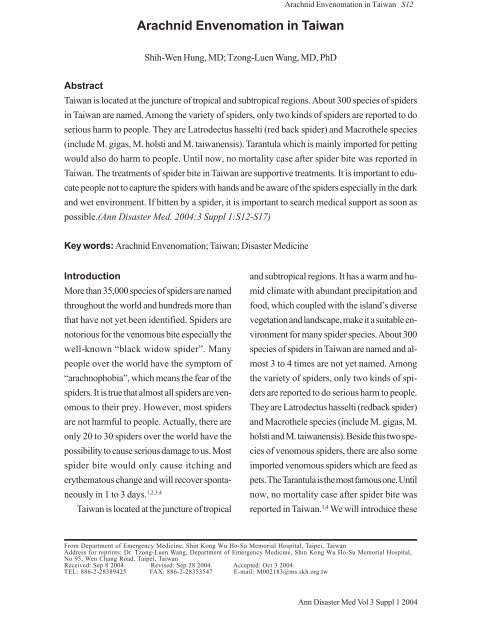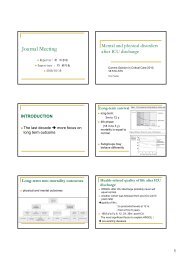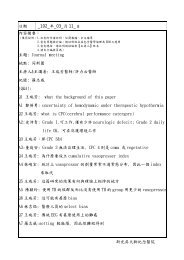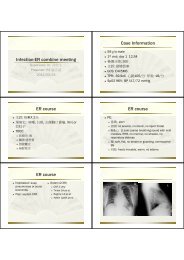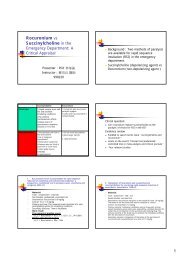Arachnid Envenomation in Taiwan
Arachnid Envenomation in Taiwan
Arachnid Envenomation in Taiwan
Create successful ePaper yourself
Turn your PDF publications into a flip-book with our unique Google optimized e-Paper software.
<strong>Arachnid</strong> <strong>Envenomation</strong> <strong>in</strong> <strong>Taiwan</strong> S12<strong>Arachnid</strong> <strong>Envenomation</strong> <strong>in</strong> <strong>Taiwan</strong>Shih-Wen Hung, MD; Tzong-Luen Wang, MD, PhDAbstract<strong>Taiwan</strong> is located at the juncture of tropical and subtropical regions. About 300 species of spiders<strong>in</strong> <strong>Taiwan</strong> are named. Among the variety of spiders, only two k<strong>in</strong>ds of spiders are reported to doserious harm to people. They are Latrodectus hasselti (red back spider) and Macrothele species(<strong>in</strong>clude M. gigas, M. holsti and M. taiwanensis). Tarantula which is ma<strong>in</strong>ly imported for pett<strong>in</strong>gwould also do harm to people. Until now, no mortality case after spider bite was reported <strong>in</strong><strong>Taiwan</strong>. The treatments of spider bite <strong>in</strong> <strong>Taiwan</strong> are supportive treatments. It is important to educatepeople not to capture the spiders with hands and be aware of the spiders especially <strong>in</strong> the darkand wet environment. If bitten by a spider, it is important to search medical support as soon aspossible.(Ann Disaster Med. 2004;3 Suppl 1:S12-S17)Key words: <strong>Arachnid</strong> <strong>Envenomation</strong>; <strong>Taiwan</strong>; Disaster Medic<strong>in</strong>eIntroductionMore than 35,000 species of spiders are namedthroughout the world and hundreds more thanthat have not yet been identified. Spiders arenotorious for the venomous bite especially thewell-known “black widow spider”. Manypeople over the world have the symptom of“arachnophobia”, which means the fear of thespiders. It is true that almost all spiders are venomousto their prey. However, most spidersare not harmful to people. Actually, there areonly 20 to 30 spiders over the world have thepossibility to cause serious damage to us. Mostspider bite would only cause itch<strong>in</strong>g anderythematous change and will recover spontaneously<strong>in</strong> 1 to 3 days. 1,2,3,4<strong>Taiwan</strong> is located at the juncture of tropicaland subtropical regions. It has a warm and humidclimate with abundant precipitation andfood, which coupled with the island’s diversevegetation and landscape, make it a suitable environmentfor many spider species. About 300species of spiders <strong>in</strong> <strong>Taiwan</strong> are named and almost3 to 4 times are not yet named. Amongthe variety of spiders, only two k<strong>in</strong>ds of spidersare reported to do serious harm to people.They are Latrodectus hasselti (redback spider)and Macrothele species (<strong>in</strong>clude M. gigas, M.holsti and M. taiwanensis). Beside this two speciesof venomous spiders, there are also someimported venomous spiders which are feed aspets. The Tarantula is the most famous one. Untilnow, no mortality case after spider bite wasreported <strong>in</strong> <strong>Taiwan</strong>. 1,4 We will <strong>in</strong>troduce theseFrom Department of Emergency Medic<strong>in</strong>e, Sh<strong>in</strong> Kong Wu Ho-Su Memorial Hospital, Taipei, <strong>Taiwan</strong>Address for repr<strong>in</strong>ts: Dr. Tzong-Luen Wang, Department of Emergency Medic<strong>in</strong>e, Sh<strong>in</strong> Kong Wu Ho-Su Memorial Hospital,No 95, Wen Chang Road, Taipei, <strong>Taiwan</strong>Received: Sep 8 2004. Revised: Sep 28 2004. Accepted: Oct 3 2004.TEL: 886-2-28389425 FAX: 886-2-28353547 E-mail: M002183@ms.skh.org.twAnn Disaster Med Vol 3 Suppl 1 2004
<strong>Arachnid</strong> <strong>Envenomation</strong> <strong>in</strong> <strong>Taiwan</strong> S14mitter substance. It <strong>in</strong>creases <strong>in</strong> frequency ofm<strong>in</strong>iature endplate potentials at the neuromuscularjunctions and causes the depletion of acetylchol<strong>in</strong>eand patchy paralysis of voluntarymuscle. It also causes release of othertransmitters, like catecholam<strong>in</strong>es, and <strong>in</strong>ducesstructural changes to sensory nerve term<strong>in</strong>als,similar to those occurr<strong>in</strong>g at motor endplates.Some study <strong>in</strong> mice showed that the tox<strong>in</strong> wouldrapidly disrupt Schwann cells. However, after48 hours, re<strong>in</strong>nervation would occur and becomecomplete normality <strong>in</strong> 8 days. 5,15,16Macrothele sp.The venoms of Macrothele are not wellcharacterized. But the tox<strong>in</strong>s of their relatives,Sydney funnel web and Hadronyche versuta,were confirmed. The tox<strong>in</strong>s of these two k<strong>in</strong>dsof spiders are robustotox<strong>in</strong> and versutox<strong>in</strong>. Bothtox<strong>in</strong>s consist of 42 am<strong>in</strong>o acid residues andthe cl<strong>in</strong>ical effects are similar. 9 The tox<strong>in</strong>s areprote<strong>in</strong>s that will b<strong>in</strong>d to autonomic and motorneurons. Not only cause neurotransmittersrelease, they will <strong>in</strong>hibit neurologically mediatedneurotransmitter release. If the peripheral nervoussystems are <strong>in</strong>volved, they will cause skeletalmuscle spasm, fasciculations and patchyweakness. Autonomic stimulation causes excessivesecretions, piloerection, tachycardia, hypertensionand cardiac arrhythmias. Hypotensionmay occur after hypertension due to catecholam<strong>in</strong>edepletion and/or impaired catecholam<strong>in</strong>erelease. After subcutaneous<strong>in</strong>jection, the venom will reach the circulationrapidly (approximately 2 m<strong>in</strong>utes). 9,17TarantulaThe venom of tarantula is rarely toxic to humans.It usually cause pa<strong>in</strong>ful sensation and is notdangerous. The typical effects are no more serousthan those of hymenopteran st<strong>in</strong>gs. Themost common reaction is a low-grade histam<strong>in</strong>eresponse. Tarantula can also attack peopleby their hairs. The hairs discharged from theTarantula can penetrate several layers of sk<strong>in</strong>or ocular tissue and cause mechanical irritation.Inhalation of urticat<strong>in</strong>g hairs may cause significantallergic rh<strong>in</strong>itis. Small mammals may suffocatewith<strong>in</strong> 2 hours if they exposure to someTaratula hairs. 9,17SymptomatologyRedback spiderSerious complications are seldom occurredwith<strong>in</strong> 3 hours after bit<strong>in</strong>g. The most bites areoccurred to the distal parts of the limbs. 5 Thebites may <strong>in</strong>itially be unnoticed but the mostcommon effect of envenomation is still the <strong>in</strong>tenselocal pa<strong>in</strong>. The site may become hot,warm, red and swell<strong>in</strong>g. If systemic envenomationoccurred, patient could have the symptomsof nausea, vomit<strong>in</strong>g, generalized sweat<strong>in</strong>g,paraesthesias, mild pyrexia, <strong>in</strong>somnia, dizz<strong>in</strong>ess,headache and hypertension. Some uncommonsymptoms and signs have been reported, <strong>in</strong>clud<strong>in</strong>gtitanic spasms, trismus, t<strong>in</strong>gl<strong>in</strong>g teeth,swollen tongue, bite site <strong>in</strong>fection, convulsions,thirst, diarrhea, anaphylaxis, blotchy rashes,patchy sweat<strong>in</strong>g, hemoptysis, dyspnea, dysuria,persistent anorexia, priapism, album<strong>in</strong>uria,leukocytosis, periorbital edema andconjunctivitis. 5,15,16Macrothele sp.Because the fangs of the spider are large andenter with considerable force, the bite is verypa<strong>in</strong>ful and the pa<strong>in</strong> will persist for hours to days.Perioral t<strong>in</strong>gl<strong>in</strong>g usually occurs with<strong>in</strong> 15 m<strong>in</strong>-Ann Disaster Med Vol 3 Suppl 1 2004
S15 <strong>Arachnid</strong> <strong>Envenomation</strong> <strong>in</strong> <strong>Taiwan</strong>utes followed by tongue spasms, lacrimation,salivation, abdom<strong>in</strong>al pa<strong>in</strong>, nausea, vomit<strong>in</strong>g,diaphoresis or severe dyspnea. Muscle fasciculationsand spasms are also common. Cardiacarrythmias and cardiac arrest may occur. Severepulmonary edema may occurs early andbe fatal. 9,17TaruntulaMild pa<strong>in</strong> similar to a p<strong>in</strong>prick is the most compla<strong>in</strong>tof Taruntula bite. However, some bitesmay cause severe pa<strong>in</strong>, local swell<strong>in</strong>g andnumbness. If the bite is near the jo<strong>in</strong>t, arthriticstiffness may last for several weeks. 12 Ocularexposure to tarantula hairs may lead to ocular<strong>in</strong>jury and the patient may have a red eye andassociated keratoconjunctivitis. Significant allergicrh<strong>in</strong>itis may be present <strong>in</strong> patients whohave <strong>in</strong>haled hairs. Anaphylaxis is a rare complicationof Taruntula hair exposure. 12,18TreatmentRedback spiderDur<strong>in</strong>g prehospital period, pressure-immobilizationbandag<strong>in</strong>g is not recommended becausethe progression of envenomation is usually slow.Ice pack<strong>in</strong>g is an effective analgesic. Supportivetreatment with ACLS protocols is required.Tetenus prophylaxis should be done. The goalof therapy is to neutralize the tox<strong>in</strong> of the spiderbite with the antivenom. However, there is noantivenom available <strong>in</strong> <strong>Taiwan</strong>. Fortunately, theoutcome of Latrodectus species bite, even themost venomous black widow spider, is good.Most patients do not need hospitalization andneed only supportive treatments. The supportivetreatments focus on alleviat<strong>in</strong>g pa<strong>in</strong> andmuscle cramp<strong>in</strong>g. The three ma<strong>in</strong> treatments arepa<strong>in</strong> relievers such as narcotics, musclerelaxants, and <strong>in</strong>travenous calcium gluconate.The effect of calcium gluconate is not clear butit seems to reduce the mortality and morbidity.The dose of calcium gluconate is 1-2ml/Kg with10% solution as slowly <strong>in</strong>travenous route, notexceed 10 ml/dose. Antihistam<strong>in</strong>e may be prescribedfor sk<strong>in</strong> itch<strong>in</strong>g and antibiotics are nothelpful. Most patients will recover fully. 5,15,16,19Macrothele sp.The prehospital care is ma<strong>in</strong>ly supportive treatmentswith ACLS protocols. Most bites do notresult <strong>in</strong> envenomation and pa<strong>in</strong> is the most commoncompla<strong>in</strong>t. When envenomation occurs,standard life support measures and antiven<strong>in</strong>therapy are necessary. However, there is noantivenum available <strong>in</strong> <strong>Taiwan</strong> and supportivetreatment is the ma<strong>in</strong> way. Tetanus immunizationmust be prescribed. Victims may be dischargedsafely <strong>in</strong> one day or so if they responsewell to antiven<strong>in</strong>. If antivenum is unavailable,the patient may need to stay more days <strong>in</strong> <strong>in</strong>tensivecare unit. Hypertension may be treatedwith alpha-blocker. Ventilator is <strong>in</strong>dicated if respiratoryfailure is noted. 9,17,19,20TarantulaSupportive care is needed <strong>in</strong> prehospital stage.Eye protective shield may be needed follow<strong>in</strong>gocular exposure to prevent the patient from rubb<strong>in</strong>gthe eyes and driv<strong>in</strong>g the hairs deeper. Inhospital, it is most important to relieve thesymptoms. Antihistam<strong>in</strong>e and analgesics may beused to relieve itch<strong>in</strong>g sensation and pa<strong>in</strong>. Tetanusimmunization is <strong>in</strong>dicated. The ophthalmologistshould be consulted for orbital <strong>in</strong>volvementsand topical broad-spectrum antibiotic may behelpful. Follow<strong>in</strong>g up <strong>in</strong> ophthalmologist departmentis recommended. If anaphylaxis occurs,Ann Disaster Med Vol 3 Suppl 1 2004
<strong>Arachnid</strong> <strong>Envenomation</strong> <strong>in</strong> <strong>Taiwan</strong> S16admission is <strong>in</strong>dicated. Chronic local dermatitiscaused by urticat<strong>in</strong>g hair could be controlledby oral steroid and antihistam<strong>in</strong>e. 12,18,22,23Education, prevention and supportive care arethe ma<strong>in</strong> management strategies for such k<strong>in</strong>dof animal <strong>in</strong>jury.Case report <strong>in</strong> <strong>Taiwan</strong> 4There is only one case report about spider envenomation<strong>in</strong> <strong>Taiwan</strong>. In May 2000, a fouryear-oldboy was bitten over left middle toe bya hidden spider <strong>in</strong> his shoes when he was wear<strong>in</strong>gthem. About 10 m<strong>in</strong>utes later, severe pa<strong>in</strong>over left foot and muscle cramp<strong>in</strong>g over leftlower leg with mild claudication were noted.There was an obvious red l<strong>in</strong>e extended fromthe wound to <strong>in</strong>gu<strong>in</strong>al area and abdom<strong>in</strong>al pa<strong>in</strong>was also noted. Two hours later, generalweakness, poor appetite, drows<strong>in</strong>ess, drool<strong>in</strong>g,vomit<strong>in</strong>g and chills happened. He was sent toemergency department ten hours later. Physicalexam<strong>in</strong>ation showed tachycardia ,a targetlesion over left middle toe and rigidity over leftlower leg. Bilateral <strong>in</strong>gu<strong>in</strong>al lymph nodes enlargementand mild abdom<strong>in</strong>al tenderness werenoted. Lab data showed leukocytosis and mildhypoglycemia. 10% Calcium gluconate, glucose-conta<strong>in</strong><strong>in</strong>gfluid, antihistam<strong>in</strong>e and prophylacticantibiotics were prescribed. Patient wasdischarged under stable condition 48 hours later.The spider was f<strong>in</strong>ally confirmed as Macrothelesp.ConclusionOf 300 species <strong>in</strong> <strong>Taiwan</strong>, only two k<strong>in</strong>ds ofspiders are reported to do serious harm topeople. They are Latrodectus hasselti (redback spider) and Macrothele species (<strong>in</strong>cludeM. gigas, M. holsti and M. taiwanensis). Tarantulawhich is ma<strong>in</strong>ly imported for pett<strong>in</strong>gwould have the same effects. There is still nomortality case after spider bite <strong>in</strong> <strong>Taiwan</strong>.References1. Chen SH. A guide to common spiders of<strong>Taiwan</strong>:64-672. Allen C. <strong>Arachnid</strong> envenomations. EmergMed Cl<strong>in</strong> North Am 1992;10:269-983. Saucier JR. <strong>Arachnid</strong> envenomation. EmergMed Cl<strong>in</strong> North Am 2004;22:405-224.Medical digest 2000;31:244-495. Hampton Roy, Sr, MD. spider bites. Availableat: URL: http://www.emedic<strong>in</strong>e.comassessed at June 6 th , 20046. Wilson DC, K<strong>in</strong>g LE. Spiders and spiderbites. Dermatol Cl<strong>in</strong> 1990;8:277-867. Simon GA Brown, MD. Spider<strong>Envenomation</strong>s, Redback. Available at:URL:http://www.emedic<strong>in</strong>e.com assessedat June 6 th , 20048. Jel<strong>in</strong>ek GA, Banham ND, Dunjey SJ. Redbackspider-bites at Fremantle Hospital,1982-1987. Med J Aust 1989;150:693-59. Simon GA Brown, MD: Spider<strong>Envenomation</strong>s, Funnel Web. Available at:URL:http://www.emedic<strong>in</strong>e.com assessedat June 6 th , 200410. Dieckmann J, Prebble J, McDonogh A, etal. Efficacy of funnel-web spider antivenom<strong>in</strong> human envenomation by Hadronychespecies. Med J Aust 1989;151:706-711.2003:239-4112.Fell SD, Kukula CL. Spider<strong>Envenomation</strong>s, Tarantula. URL:http://www.emedic<strong>in</strong>e.comAnn Disaster Med Vol 3 Suppl 1 2004


